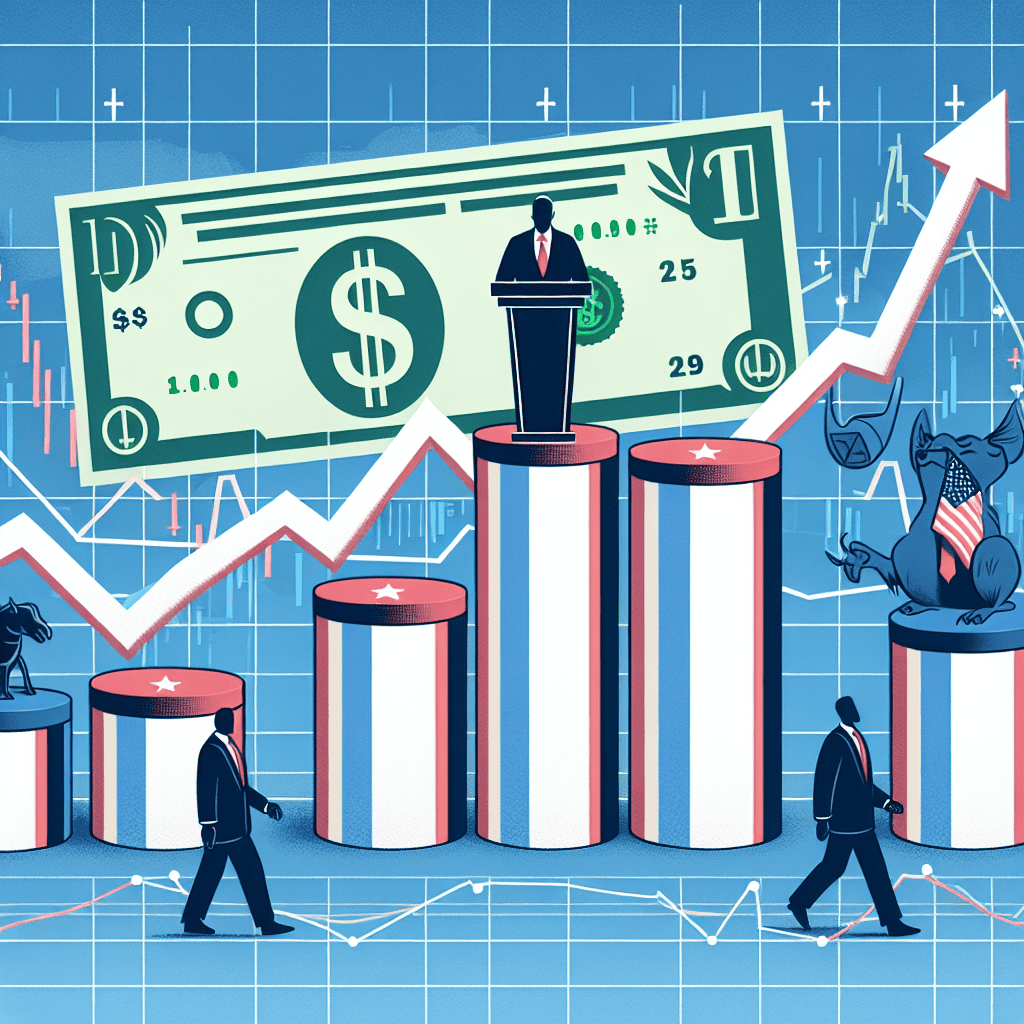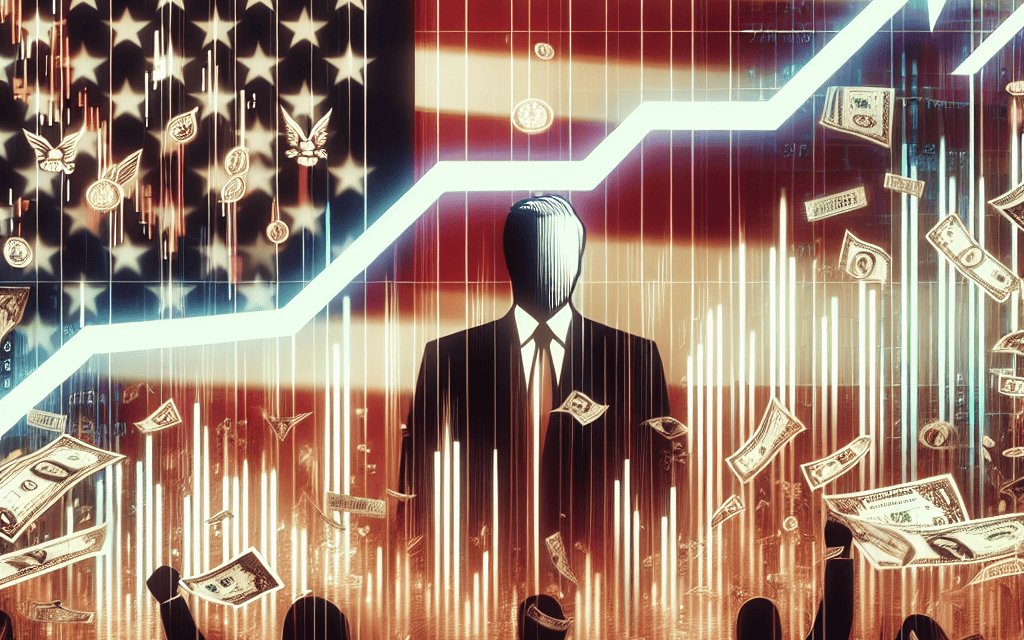“US Stocks and Dollar Surge: Markets Rally as Trump Nears Victory”
Introduction
As the U.S. presidential election unfolds, financial markets are reacting to the potential victory of Donald Trump, with significant movements observed in both U.S. stocks and the dollar. Investors are closely monitoring the situation, as Trump’s policies and economic plans could have substantial implications for market dynamics. The anticipation of a Trump victory has led to a surge in U.S. stocks, reflecting investor optimism about potential tax cuts, deregulation, and infrastructure spending that could stimulate economic growth. Simultaneously, the U.S. dollar is experiencing a notable rise, driven by expectations of increased fiscal stimulus and potential shifts in trade policies. This market update delves into the factors driving these financial trends and the potential long-term impacts on the global economic landscape.
Impact Of Trump’s Potential Victory On US Stock Markets
As the United States approaches a pivotal moment in its political landscape, the financial markets are responding with notable vigor. The prospect of a potential victory for Donald Trump in the upcoming election has sent ripples through the US stock markets, resulting in a significant surge. Investors, analysts, and market participants are closely monitoring these developments, as the implications of a Trump victory could have far-reaching effects on both domestic and global economic landscapes.
To begin with, the stock market’s reaction to political events is often a reflection of investor sentiment and expectations regarding future economic policies. In this context, the recent surge in US stocks can be attributed to the anticipation of Trump’s pro-business policies, which were a hallmark of his previous administration. These policies, which included tax cuts, deregulation, and a focus on domestic manufacturing, were generally well-received by the business community and investors alike. Consequently, the possibility of their reimplementation is fueling optimism among market participants.
Moreover, the sectors that stand to benefit the most from a Trump victory are already experiencing heightened activity. For instance, the energy sector, which thrived under Trump’s previous tenure due to deregulation and support for fossil fuels, is witnessing increased investor interest. Similarly, the financial sector, which benefited from reduced regulatory constraints, is also seeing a positive uptick. These sector-specific movements underscore the broader market’s anticipation of a return to policies that prioritize economic growth and corporate profitability.
In addition to the stock market, the US dollar is also experiencing a surge, reflecting increased confidence in the American economy’s prospects under a potential Trump administration. A stronger dollar can have a multifaceted impact on the economy, influencing everything from import prices to international trade dynamics. While a robust dollar can make US exports more expensive and potentially dampen demand abroad, it also signals investor confidence in the stability and growth potential of the US economy.
However, it is essential to consider the broader implications of these market movements. While the immediate reaction may be positive, the long-term effects of a Trump victory on the economy remain uncertain. Potential challenges include geopolitical tensions, trade disputes, and domestic policy shifts that could introduce volatility into the markets. Investors must weigh these factors carefully as they navigate the evolving landscape.
Furthermore, it is crucial to recognize that market reactions are not solely driven by political developments. Economic indicators, corporate earnings reports, and global events also play significant roles in shaping market dynamics. As such, while the prospect of a Trump victory is a key factor influencing current market trends, it is not the sole determinant of future market performance.
In conclusion, the surge in US stocks and the dollar in response to the potential victory of Donald Trump underscores the complex interplay between politics and financial markets. As investors and analysts assess the implications of this development, it is clear that the markets are positioning themselves for a possible return to policies that prioritize economic growth and corporate profitability. However, the long-term impact of these developments remains uncertain, and market participants must remain vigilant as they navigate the evolving economic landscape. As the election approaches, the financial markets will undoubtedly continue to react to new information, reflecting the ever-changing dynamics of the global economy.
Analysis Of The Dollar Surge Amid Election Uncertainty
As the United States presidential election unfolds, financial markets are experiencing significant volatility, with the US dollar and stock markets showing notable surges. This phenomenon can be attributed to the increasing likelihood of a victory for Donald Trump, which has injected a sense of optimism among investors. The dollar’s strength, in particular, is a focal point of analysis, as it reflects broader economic sentiments and expectations. Understanding the dynamics behind this surge requires a closer examination of the interplay between political developments and market reactions.
Initially, the dollar’s rise can be linked to the perception of stability and continuity that a Trump victory might bring to certain sectors of the economy. Investors often seek safe havens during periods of uncertainty, and the dollar, as the world’s primary reserve currency, naturally benefits from this tendency. Moreover, Trump’s economic policies, which emphasize tax cuts and deregulation, are generally viewed favorably by the business community. These policies are anticipated to stimulate economic growth, thereby enhancing the attractiveness of US assets and, consequently, the dollar.
Furthermore, the stock market’s upward trajectory is closely tied to the dollar’s performance. A stronger dollar often signals confidence in the US economy, encouraging both domestic and international investors to increase their exposure to American equities. This influx of capital can drive stock prices higher, creating a positive feedback loop that further bolsters the dollar. Additionally, sectors such as energy, finance, and manufacturing, which are poised to benefit from Trump’s policy agenda, have seen particularly robust gains, contributing to the overall market rally.
However, it is essential to consider the broader context of this market behavior. The election’s outcome remains uncertain, and the potential for legal challenges and recounts could prolong this period of volatility. In such a scenario, the dollar’s strength might be tested, as prolonged uncertainty could undermine investor confidence. Moreover, the global economic landscape, still reeling from the impacts of the COVID-19 pandemic, adds another layer of complexity. The interplay between domestic political developments and international economic conditions will be crucial in determining the dollar’s trajectory in the coming weeks.
In addition to these factors, the Federal Reserve’s monetary policy stance plays a critical role in shaping the dollar’s performance. The central bank’s commitment to maintaining low interest rates to support economic recovery has implications for currency valuation. While low rates typically exert downward pressure on a currency, the current environment of heightened uncertainty and risk aversion may counteract this effect, as investors prioritize safety over yield.
In conclusion, the surge in US stocks and the dollar amid the election uncertainty underscores the intricate relationship between political developments and market dynamics. While a potential Trump victory has instilled a sense of optimism among investors, the path forward remains fraught with challenges. The interplay of domestic policies, global economic conditions, and central bank actions will continue to influence market behavior. As the situation evolves, investors and analysts alike will need to remain vigilant, adapting to new information and adjusting their strategies accordingly. This period of heightened volatility serves as a reminder of the complex and often unpredictable nature of financial markets, where political events can have far-reaching implications for economic outcomes.
Key Sectors Benefiting From Trump’s Economic Policies
As the US stock market experiences a significant surge alongside the strengthening of the dollar, investors and analysts are closely examining the key sectors poised to benefit from the economic policies anticipated under a potential Trump administration. The financial markets, often seen as a barometer of investor sentiment, have reacted positively to the prospect of policies that emphasize deregulation, tax cuts, and infrastructure spending. These elements are expected to create a favorable environment for several industries, thereby driving growth and profitability.
One of the primary sectors likely to benefit from Trump’s economic agenda is the financial industry. The promise of deregulation, particularly the potential rollback of Dodd-Frank regulations, has been met with enthusiasm by banks and financial institutions. Reduced regulatory burdens could lead to increased lending and investment activities, thereby boosting profitability. Moreover, the prospect of rising interest rates, which often accompanies economic growth, could further enhance the earnings potential of banks by widening the spread between lending and deposit rates.
In addition to the financial sector, the energy industry stands to gain significantly from Trump’s policies. The administration’s focus on energy independence and support for fossil fuels, including coal, oil, and natural gas, is expected to stimulate growth within this sector. By reducing regulatory constraints and opening up more federal lands for drilling, energy companies could see increased production and exploration activities. This, in turn, could lead to job creation and a more robust domestic energy market, further strengthening the sector’s outlook.
Furthermore, the construction and infrastructure sectors are anticipated to experience a substantial boost. Trump’s commitment to revitalizing America’s infrastructure through significant investment in roads, bridges, and public works projects is likely to create numerous opportunities for construction companies. This influx of government spending could not only drive demand for construction materials and labor but also stimulate related industries such as manufacturing and transportation. As a result, companies involved in these sectors may see enhanced growth prospects and increased profitability.
The defense sector is another area that could benefit from Trump’s economic policies. With a focus on strengthening national security and increasing defense spending, companies involved in the production of military equipment and technology are likely to experience heightened demand. This could lead to expanded contracts and revenue streams for defense contractors, thereby bolstering their financial performance.
Moreover, the healthcare sector may also see some positive impacts, although the effects could be more nuanced. While the potential repeal or modification of the Affordable Care Act introduces uncertainty, certain segments of the healthcare industry, such as pharmaceuticals and biotechnology, could benefit from a more favorable regulatory environment. Reduced barriers to drug approvals and increased innovation incentives could drive growth and investment in these areas.
In conclusion, as the US stock market and dollar continue to surge in anticipation of a Trump victory, several key sectors are positioned to benefit from the expected economic policies. The financial, energy, construction, defense, and healthcare industries are among those likely to experience growth and increased profitability. By focusing on deregulation, infrastructure investment, and national security, these policies could create a conducive environment for economic expansion, thereby enhancing the prospects for these sectors. As investors navigate this evolving landscape, understanding the potential impacts on these industries will be crucial for making informed decisions.
Historical Market Reactions To Presidential Elections

Throughout history, presidential elections in the United States have often been pivotal moments for financial markets, with investors closely monitoring the potential economic policies of incoming administrations. The anticipation and outcome of these elections can lead to significant market volatility, as traders and investors adjust their portfolios in response to the perceived economic implications of a new presidency. The 2016 presidential election, which saw Donald Trump emerge as the victor, serves as a notable example of how markets can react to such political events.
In the lead-up to the 2016 election, market participants were largely uncertain about the potential impact of a Trump presidency. His campaign promises, which included tax cuts, deregulation, and increased infrastructure spending, were seen by some as potentially stimulative for the economy. However, his protectionist trade policies and unpredictable rhetoric also introduced a degree of uncertainty. As election night unfolded and it became increasingly clear that Trump was likely to win, initial market reactions were marked by volatility. Futures markets, which had anticipated a Hillary Clinton victory, initially plummeted, reflecting investor anxiety over the unexpected outcome.
However, as the dust settled, a remarkable shift occurred. The US stock market began to rally, with the Dow Jones Industrial Average, the S&P 500, and the Nasdaq Composite all experiencing significant gains in the days following the election. This surge was largely driven by investor optimism regarding Trump’s pro-business agenda, which was expected to boost corporate profits and economic growth. The financial sector, in particular, benefited from expectations of deregulation, while industrial stocks gained on the prospect of increased infrastructure spending.
Simultaneously, the US dollar also experienced a notable appreciation. Investors anticipated that Trump’s policies would lead to higher interest rates, as fiscal stimulus measures could potentially spur inflation. This expectation of rising rates made the dollar more attractive to investors seeking higher returns, leading to its strengthening against other major currencies. The dollar’s surge was further supported by the Federal Reserve’s indication of a potential rate hike in response to the anticipated fiscal expansion.
Historically, market reactions to presidential elections have varied depending on the candidates’ platforms and the broader economic context. For instance, the election of Barack Obama in 2008 occurred amidst the global financial crisis, leading to a more subdued market response as investors grappled with the ongoing economic turmoil. In contrast, the 2016 election took place during a period of economic recovery, allowing for a more pronounced market reaction to the anticipated policy shifts.
It is important to note that while elections can trigger short-term market movements, the long-term impact of a presidency on financial markets is influenced by a multitude of factors, including legislative success, global economic conditions, and unforeseen events. As such, investors often remain vigilant, continuously assessing the evolving political and economic landscape.
In conclusion, the 2016 US presidential election serves as a compelling case study of how markets can react to political change. The initial volatility followed by a surge in stocks and the dollar underscores the complex interplay between investor sentiment, policy expectations, and economic fundamentals. As future elections approach, market participants will undoubtedly continue to scrutinize the potential implications of new leadership, seeking to navigate the opportunities and challenges that lie ahead.
Investor Strategies During Political Transitions
As the political landscape in the United States undergoes significant shifts, investors are keenly observing the financial markets to strategize their next moves. The recent surge in US stocks and the dollar, coinciding with Donald Trump’s approach to a potential victory, has prompted a reevaluation of investment strategies during political transitions. Understanding the dynamics at play is crucial for investors aiming to navigate these turbulent times effectively.
Political transitions often bring about a degree of uncertainty, which can lead to volatility in financial markets. However, they also present unique opportunities for investors who are prepared to adapt their strategies. The recent rally in US stocks and the strengthening of the dollar can be attributed to several factors, including market expectations of policy changes that could favor certain sectors. For instance, Trump’s economic policies, which historically emphasized tax cuts and deregulation, may lead investors to anticipate a more business-friendly environment, potentially boosting corporate profits and stock valuations.
In light of these developments, investors might consider rebalancing their portfolios to capitalize on sectors that could benefit from such policy shifts. Historically, industries such as energy, financials, and manufacturing have responded positively to deregulatory measures and tax incentives. Therefore, allocating resources to these sectors could prove advantageous. Additionally, the strengthening dollar, while beneficial for importers and consumers, may pose challenges for exporters. Investors should be mindful of companies with significant international exposure, as a strong dollar can impact their competitiveness abroad.
Moreover, political transitions often lead to changes in fiscal and monetary policies, which can influence interest rates and inflation. Investors should closely monitor the Federal Reserve’s actions and statements, as any adjustments in interest rates could have far-reaching implications for bond markets and borrowing costs. In this context, diversifying fixed-income investments and considering inflation-protected securities might be prudent strategies to mitigate potential risks.
While the immediate market reactions to political events can be pronounced, it is essential for investors to maintain a long-term perspective. Short-term volatility should not overshadow the fundamental strengths of the US economy, which remains resilient and innovative. By focusing on companies with strong balance sheets, competitive advantages, and sustainable growth prospects, investors can position themselves to weather political uncertainties and capitalize on future opportunities.
Furthermore, geopolitical considerations should not be overlooked. Political transitions in the US can have ripple effects on global markets, influencing trade relations and international alliances. Investors with global portfolios should assess the potential impact of US policy changes on foreign markets and adjust their strategies accordingly. Diversification across regions and asset classes can help mitigate risks associated with geopolitical shifts.
In conclusion, political transitions, such as the one currently unfolding with Trump’s potential victory, present both challenges and opportunities for investors. By staying informed, adapting strategies to align with anticipated policy changes, and maintaining a diversified portfolio, investors can navigate the complexities of these transitions. While market reactions may be immediate and pronounced, a disciplined and forward-looking approach will enable investors to capitalize on the evolving landscape and achieve their long-term financial goals. As always, consulting with financial advisors and staying abreast of market developments will be crucial in making informed investment decisions during these dynamic times.
Comparing Market Volatility In Past Elections
In the realm of financial markets, the intersection of politics and economics often creates a dynamic landscape, particularly during election periods. As the US stocks and dollar surge with the approach of a Trump victory, it is essential to compare this market volatility with past elections to understand the broader implications. Historically, elections have been pivotal moments for financial markets, often characterized by heightened volatility as investors react to the potential policy shifts that accompany a change in administration. The current market behavior, marked by a surge in US stocks and the dollar, is reminiscent of previous election cycles, yet it also presents unique characteristics that merit closer examination.
To begin with, it is important to recognize that market volatility during elections is not a novel phenomenon. For instance, the 2008 election, which resulted in Barack Obama’s presidency, was marked by significant market fluctuations. The financial crisis at the time exacerbated these movements, as investors grappled with uncertainty about the future economic landscape. Similarly, the 2016 election, which saw Donald Trump ascend to the presidency, was accompanied by a notable market reaction. In the immediate aftermath of Trump’s victory, US stocks initially plummeted, only to rebound sharply as investors recalibrated their expectations based on anticipated pro-business policies.
Transitioning to the present, the current surge in US stocks and the dollar as Trump approaches victory can be attributed to several factors. Investors are likely responding to the prospect of continued tax cuts, deregulation, and other business-friendly policies that characterized Trump’s first term. Moreover, the anticipation of a stable economic environment under a familiar administration may be contributing to investor confidence, thus driving the markets upward. This behavior aligns with historical patterns where markets often react positively to the prospect of policy continuity.
However, it is crucial to consider the unique aspects of the current election cycle that differentiate it from past elections. The global economic landscape has been significantly altered by the COVID-19 pandemic, introducing unprecedented challenges and uncertainties. As a result, the market’s response to the election is not solely influenced by domestic policy considerations but also by the broader context of global economic recovery. This adds a layer of complexity to the current market dynamics, as investors weigh the potential impact of US leadership on international trade, supply chains, and global economic stability.
Furthermore, the role of technology and social media in shaping public perception and market sentiment has grown exponentially since previous elections. The rapid dissemination of information, coupled with the influence of digital platforms, has the potential to amplify market reactions, both positive and negative. This evolution in information flow underscores the need for investors to remain vigilant and discerning in their analysis of market trends.
In conclusion, while the surge in US stocks and the dollar as Trump approaches victory is consistent with historical patterns of market volatility during elections, it is essential to recognize the unique factors at play in the current cycle. By comparing these dynamics with past elections, investors can gain a more nuanced understanding of the forces driving market behavior. As always, a careful consideration of both domestic and global factors is crucial in navigating the complexities of financial markets during election periods.
Long-term Implications Of A Trump Victory On Global Markets
As the US presidential election unfolds, the financial markets are reacting with notable volatility, particularly as Donald Trump edges closer to a potential victory. The immediate response has been a surge in US stocks and the dollar, reflecting investor sentiment and expectations of future economic policies. However, beyond the immediate market reactions, a Trump victory could have profound long-term implications for global markets, influencing trade policies, international relations, and economic growth trajectories.
To begin with, a Trump presidency is likely to bring about significant changes in trade policies. Historically, Trump has advocated for protectionist measures, aiming to renegotiate trade agreements to favor American interests. This approach could lead to increased tariffs and trade barriers, potentially disrupting global supply chains. While such policies might benefit certain domestic industries in the short term, they could also lead to retaliatory measures from trading partners, thereby affecting global trade volumes and economic growth. Consequently, countries heavily reliant on exports to the US might experience economic slowdowns, prompting shifts in their trade strategies and alliances.
Moreover, Trump’s stance on deregulation and tax reforms could have lasting effects on the US economy, with ripple effects across the globe. By reducing corporate taxes and rolling back regulations, Trump aims to stimulate domestic investment and job creation. This could lead to increased competitiveness of US companies on the global stage, potentially attracting foreign investment. However, the long-term sustainability of such policies remains uncertain, particularly if they lead to increased fiscal deficits and national debt. The global markets might react to these fiscal policies with caution, as concerns over economic stability and inflationary pressures could arise.
In addition to economic policies, a Trump victory could alter the geopolitical landscape, influencing global markets in various ways. Trump’s approach to international relations, characterized by a focus on bilateral agreements and a more isolationist stance, might lead to shifts in global alliances. This could impact global markets by altering the flow of capital and investments, as countries reassess their economic and political ties with the US. Furthermore, Trump’s policies on energy independence and climate change could affect global energy markets, particularly if the US increases its production of fossil fuels, thereby influencing global oil prices and energy investments.
Another aspect to consider is the potential impact on emerging markets. A stronger US dollar, as seen in the immediate market reaction, could pose challenges for emerging economies with significant dollar-denominated debt. As the cost of servicing this debt rises, these countries might face financial strain, leading to capital outflows and currency depreciation. This could result in tighter financial conditions and slower economic growth in these regions, affecting global market dynamics.
In conclusion, while the immediate market reactions to a potential Trump victory are characterized by a surge in US stocks and the dollar, the long-term implications for global markets are complex and multifaceted. Changes in trade policies, economic strategies, and geopolitical relations could reshape the global economic landscape, influencing trade flows, investment patterns, and economic growth. As investors and policymakers navigate these uncertainties, the global markets will continue to adjust, reflecting the evolving economic and political realities of a Trump presidency.
Q&A
1. **Question:** How did US stocks react as Trump approached victory?
– **Answer:** US stocks experienced a surge as investors anticipated potential policy changes favoring business and economic growth.
2. **Question:** What sectors saw significant gains during the stock surge?
– **Answer:** Financials, industrials, and energy sectors saw significant gains due to expectations of deregulation and infrastructure spending.
3. **Question:** How did the US dollar perform in the market as Trump neared victory?
– **Answer:** The US dollar strengthened significantly against other major currencies, reflecting investor confidence in the US economy.
4. **Question:** What was the market’s expectation regarding Trump’s economic policies?
– **Answer:** The market expected tax cuts, deregulation, and increased infrastructure spending, which were seen as positive for economic growth.
5. **Question:** How did international markets react to the US stock and dollar surge?
– **Answer:** International markets were mixed, with some experiencing volatility due to concerns about potential trade policy changes.
6. **Question:** What impact did the dollar surge have on commodities?
– **Answer:** The dollar surge generally put downward pressure on commodities priced in dollars, such as gold and oil, making them more expensive for foreign buyers.
7. **Question:** What were investors’ concerns despite the market surge?
– **Answer:** Investors were concerned about potential trade wars, geopolitical tensions, and the long-term impact of Trump’s policies on the global economy.
Conclusion
The surge in US stocks and the dollar as Trump approaches victory reflects investor optimism about potential pro-business policies, including tax cuts and deregulation, anticipated under his administration. This market reaction suggests confidence in economic growth prospects, although it also introduces potential volatility due to uncertainties surrounding trade policies and geopolitical tensions. Overall, the financial markets are responding positively to the expected economic agenda, but investors remain cautious about the long-term implications of Trump’s presidency on global trade and economic stability.





